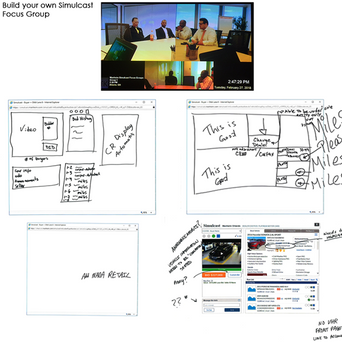Simulcast
Bridging the Physical and Digital
Challenge
Simulcast is a core platform that wholesale vehicle buyers rely on to participate in live digital auctions. Buyers are making split-second decisions on high-value vehicles, often without the ability to inspect them physically. While the tool had been dependable for years, it was showing its age—struggling to keep pace with modern technology, rising user expectations, and competitor offerings.
Adoption had also been limited, as many dealers preferred the in-lane experience where they could physically walk around and inspect vehicles before bidding.

Why UX Was Critical
Simulcast wasn’t just a digital product—it was a complex service ecosystem connecting buyers, sellers, auctioneers, and supporting staff in real time. To succeed, the experience had to orchestrate multiple user journeys and system layers, ensuring speed, clarity, and trust at every touchpoint.
Customer Experience
-
Live, high-pressure interactions: Fast-paced online and in-lane bidding, real-time updates and instant decision-making. The UI had to clearly communicate bid status, timing, and vehicle details under pressure.
-
Planned activities: Before auctions, users researched vehicles, set proxy bids, and curated watch lists. UI designs needed to make these preparatory actions intuitive and easily retrievable once the live event began.
-
Hybrid participation: The experience needed to feel seamless for in-lane and online buyers, sellers managing inventory, and auctioneers facilitating both live and digital bidding simultaneously.
Processes and Supporting Systems
-
Real-time data synchronization: Behind the scenes, systems had to broadcast bids, updates, and vehicle info to hundreds of participants without latency.
-
Team member coordination: Auction clerks and support staff used internal tools to monitor activity, resolve conflicts and manage transactions across physical and digital channels.
-
Business continuity: Integrations with inventory management and post-sale systems ensured a continuous flow from bidding to final sale, whether online or in person.
Pain Points and Opportunities
Historically, Simulcast adoption lagged because many dealers favored in-lane bidding, valuing physical inspection and interpersonal trust. The redesign sought to replicate that confidence digitally—reducing friction, surfacing transparency, and making online participation feel equally reliable.
The Redesign
Our challenge was to transform Simulcast into a modern, confidence-building digital experience that could replace the physical lane.
-
Modernized UI: A clean, familiar, and intuitive design that reduced learning curves for dealers moving from physical to digital auctions.
-
Decision-support tools: Enriched vehicle data, more relevant context, and real-time insights at buyers’ fingertips to drive smarter, faster decisions.
-
Trust & confidence: Design choices focused on bridging the gap between physical inspection and digital buying, reducing friction and building user trust.
Impact
With the new revamp, the experience is clean, familiar and modern, with more relevant vehicle information that wholesale dealers need before making an online purchasing decision. The new experience raises buyer confidence by providing more information at their fingertips.
The redesigned Simulcast not only carried the industry through the unprecedented disruption of Covid lockdowns, it enabled buyers to continue purchasing vehicles and running their businesses—whether from home or the auction floor. Dealers who had long resisted digital adoption turned to the platform out of necessity, and many continued using it even after physical auctions reopened. What began as a crisis response became a lasting digital transformation in wholesale vehicle buying.

Modernized a complex platform to improve usability, confidence, and adoption, guided by research and close collaboration with cross-functional teams.
-
Lead Interaction Designer
-
Visual Designer
-
User Requirements










